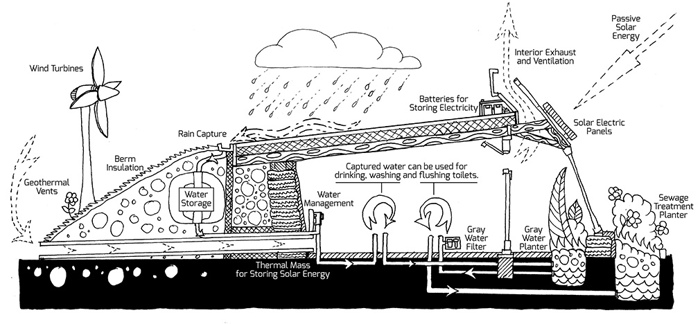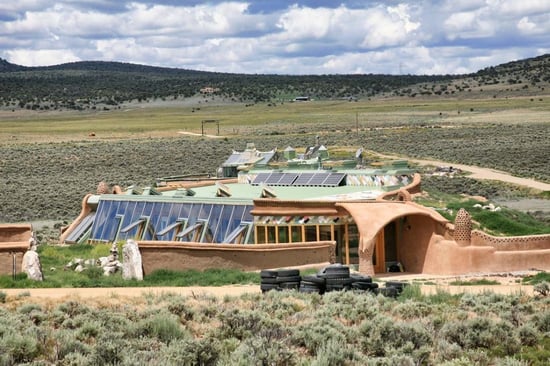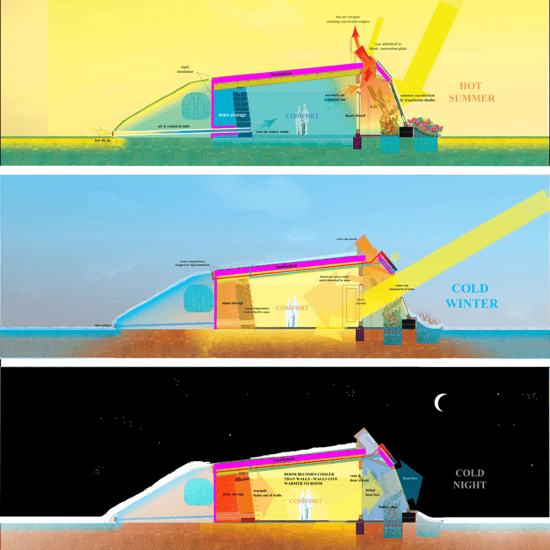New Energy Insights
- Home /
- New Energy Insights /
- Earthships: Engineering Sustainable Architecture
Concerns about climate change and our environmental footprints are widespread and, as a result, more and more people are trying to think of ways to calculate, monitor, and reduce their environmental impact. The things you buy, the car you drive, the food you eat, and what you throw away vs recycle are behaviors we typically think about when looking for methods to reduce our carbon footprint. Few of us go beyond adjusting these everyday habits, but there is immense value in analyzing bigger picture items like the homes we live in, the appliances we own, the energy (electricity / gas) we use for living essentials and how that energy is produced. How many of us use environmental impacts as a primary gauge when searching for our “dream” home? Many of us are reluctant to go without the niceties and conveniences that are expected in our modern culture. The idea of reducing one’s carbon footprint is often associated with changing one’s lifestyle and daily habits - this takes constant thought and energy, and not everyone is keen on making personal sacrifices to reduce their footprint. By incorporating sustainable principles and practices into the design of our homes and living spaces, we can make these choices obvious, easy, and rewarding – enabling us to live a more eco-conscious lifestyle without sacrificing on modern-day comforts.
Increased knowledge and awareness of environmental issues, paired with advances in technology, have led to a revolution in modern architecture geared toward reducing the carbon footprint of the spaces we live in. The leading approaches to achieving these carbon reductions are 1) renovating existing structures to reduce their environmental impact, and 2) building new structures with their environmental impact in mind. Both approaches require effective and efficient insulation, energy efficient appliance choices, using recycled or environmentally benign building materials, incorporating passive energy production and storage into the structure, and water and waste management. All of these factors work in tandem towards achieving the goal of net zero carbon architecture, where a structure is highly energy efficient and fully powered by renewable energy sources [1]. In some cases, buildings can actually produce more energy than they use, and if properly equipped can send this excess renewable energy into the grid and achieve a carbon positive status, where they reduce demand for fossil fuels [1].
The Earthship Biotecture project, pioneered by architect Michael Reynolds, is an example of a sustainable architecture movement that has gained traction in recent years. Earthships combine many of the elements mentioned above to create homes that operate self-sufficiently by repurposing, recycling, and harvesting natural and renewable resources, giving residents the ability to live off the grid and reduce their environmental impact [2, 3]. Earthship homes are designed based on the principle that there are six essential living conditions that must be met for humans to live contently while minimizing their impact on the planet. These essential needs include [2, 3]:
- Garbage management
- Clean water
- Sewage Management
- Food
- Energy (i.e. electricity)
- Comfortable shelter
Figure 1 below is an example of an Earthship design which outlines how the system can meet these six essential needs. Figure 2 depicts a completed project.

Figure 1: An example Earthship structure and its design principles [2]

Figure 2: A completed Earthship structure in New Mexico [4]
Earthships are designed to meet all of the following living essentials without relying on conventional utilities [2, 5]:
- Garbage management
-
- Repurposed and recycled materials are used in the building’s construction. Tires tightly packed with earth are used to form structural walls, cans and bottles are used to create smaller interior walls with adobe mud used as a natural mortar, and ideally much of the interior furnishings of the home are built with reclaimed wood and metal materials.
- Clean water
-
- Water is captured in the form of rain and snow melt that flows from the roof through a rain capture gutter into a water storage container. This “catch water” is then filtered and can be made into potable drinking water or used in the bathroom, kitchen, or for laundry.
- Sewage management
-
- Used grey water is sent to interior botanical cells, where plants’ root systems absorb and treat the water, removing dissolved nutrients which fertilize the plant and filter out solid waste particles suspended in the water. This water is then sent to the toilet tank to be used for flushing. Wastewater from toilets is transported outside of the house through a plumbing system and is used to fertilize outdoor landscaping projects.
- Food
- Grey water (any previously used water that doesn’t have fecal contamination) is used to water interior planting beds located in the south-facing windowed “greenhouse” section of the home, enabling the tenant to grow organic food and decorative plants year-round.
- Energy
-
- The electricity in an Earthship building is produced using renewable resources, typically a combination of solar and wind technologies, accompanied by batteries for energy storage. The structures are also designed using very efficient appliances, lighting, pumps, and refrigeration which helps minimize the electrical demand.
- Comfortable shelter
-
- Earthship structures are designed to heat and cool themselves without using any electricity and without burning fossil fuels, providing comfortable and reliable shelter year-round. This is accomplished by building thick and dense walls and floors which operate as thermal masses, absorbing heat during the day and radiating heat at night, providing both efficient heating in the colder months and efficient cooling in the warmer months. Interior vents are also installed for fresh air circulation and help release hot air when cooling the structure. Through this mechanism, the structure maintains a comfortable temperature in a variety of climates. Figure 3 demonstrates this self-sufficient heating and air conditioning design [4].

Figure 3: An Earthship building naturally regulates its internal temperature by utilizing solar radiation and thermal mass construction [4].
While this heating and cooling design works quite well in New Mexico, which has an arid/semi-arid climate with light precipitation, low relative humidity and high levels of sunshine, the same performance may not be achievable in extremely cold environments without supplemental insulation or heating technology [6]. While any one model might not work perfectly in every environment, the design principles can easily be adapted and built upon to create a customized, sustainable, and self-sufficient home suitable to many climates. That being said, Earthship structures are not limited to just New Mexico: Global Model Earthships are found in several countries around the world including France, Germany, Mexico, and Canada [3, 7].
Earthship structures meet needs beyond those of just eco-minded people. The innovative way Earthships recycle materials is an approach well suited for construction efforts in areas affected by natural disasters. For example, after the devastating 2010 earthquake in Haiti, a team of 40 local volunteers built an Earthship home out of discarded rubber tires in less than four days, providing shelter and enough power to charge essential electronics [8].
After reading this, one might wonder what aspects of the Earthship designs can be realistically implemented in our existing homes. If you are excited by Earthship’s creative designs, you may want to consider building your own Earthship home or a similar sustainable structure. While hiring the Earthship Biotecture company to build your sustainable home isn’t necessarily cheaper than building a conventional home, doing some (or all) of the work yourself can greatly reduce the cost. And if you don’t want to live in a full-fledged Earthship home, you can always incorporate some of their design principles into a conventional house to make it more sustainable and self-reliant. If you are leaning towards the latter, some great options are installing solar, wind or geothermal technology in your current home, composting and growing your own food, using rain barrels to capture water which can be used to water both edible and decorative plants, and finding innovative ways to reuse and recycle materials in DIY projects.
The solar industry should pay attention to eco-minded architecture ventures like the Earthships project, not only because of its environmental benefits, but also because these projects represent a source of potential project opportunities. Most sustainable and “green” structures incorporate solar technology into their design as a method to passively create electricity independent from the grid and with zero carbon emissions. Our global environmental impact will continue to grow in tandem with the increasing human population, and I believe environmentally geared thinking and design in architecture will become the norm, rather than the exception. Solar technology is increasingly being incorporated into new building designs, and I think we can expect this trend to continue [9]. This means more business for the solar industry and greater carbon emissions reductions, bringing us one step closer to a cleaner, greener future.
How Can New Energy Equity Help You Reach Your Solar Goals?
References:
- https://ecosave.com.au/news-insights/coming-to-terms-with-sustainability-terms-net-zero-vs-carbon-neutral-vs-carbon-negative-vs-carbon-positive-what-do-they-mean-exactly/
- https://earthshipbiotecture.com/design-principles/
- https://www.earthshipglobal.com/
- https://urbannext.net/earthship-biotecture/#:~:text=Designed%20to%20produce%20water%2C%20electricity,%2C%20solar%2D%20and%20wind%2Dgenerated
- https://www.earthshipglobal.com/design-principles
- https://www.ecohome.net/guides/1161/do-earthships-work-in-cold-climates/
- https://earthshipbiotecture.com/earthship-models/global-earthship-design/
- https://www.architecturaldigest.com/story/architect-promoting-self-sustaining-architecture-around-globe
- https://www.ny-engineers.com/blog/trends-and-future-of-solar-design-in-the-construction-industry
Stay up-to-date with New Energy Equity by joining our mailing list.

-1.png)
